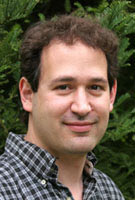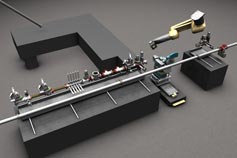
Handy Links
SLAC News Center
SLAC Today
- Subscribe
- Archives: Feb 2006-May 20, 2011
- Archives: May 23, 2011 and later
- Submit Feedback or Story Ideas
- About SLAC Today
SLAC News
Lab News
- Interactions
- Lightsources.org
- ILC NewsLine
- Int'l Science Grid This Week
- Fermilab Today
- Berkeley Lab News
- @brookhaven TODAY
- DOE Pulse
- CERN Courier
- DESY inForm
- US / LHC
SLAC Links
- Emergency
- Safety
- Policy Repository
- Site Entry Form

- Site Maps
- M & O Review
- Computing Status & Calendar
- SLAC Colloquium
- SLACspeak
- SLACspace
- SLAC Logo
- Café Menu
- Flea Market
- Web E-mail
- Marguerite Shuttle
- Discount Commuter Passes
-
Award Reporting Form
- SPIRES
- SciDoc
- Activity Groups
- Library
Stanford
Around the Bay
X-Ray Flip Books

Researchers plan to shine the ultra fast, super bright X-rays from the Linac Coherent Light Source on solid materials to watch their atoms wiggle. They'll use an LCLS instrument called the X-ray Pump Probe, or XPP, to learn more about the physics of solids through these atomic dances. Physicist David Reis will be joining the PULSE Institute for Ultrafast Energy Science in January to continue his studies of solids using the XPP.
Solid-state physicists like Reis want to understand how the arrangements and motions of atoms inside solids produce a material's physical properties. These properties can be as simple as how heat or electrons flow through the material.
"This is basic research. These are things that aren't in textbooks and we're trying to study them and learn about them," said David Fritz, who was one of Reis' graduate students at the University of Michigan and is now the XPP instrument scientist at LCLS. "It's going to be great having David's expertise on site."
Compared to previous X-ray sources, the LCLS beam will allow the scientists to study quicker and smaller atomic changes inside solids. The XPP instrument will be able to record atomic movements that start and stop in 100 quadrillionths of a second, or 100 femtoseconds. Researchers will also be able to capture more subtle atomic wiggles than previous X-ray sources with the high intensity of the LCLS beam.
A pump probe experiment can produce a movie of atoms dancing inside a solid, liquid or gas. Each experiment consists of a repeated sequence of two different light pulses.
The first light pulse is produced by an optical laser and acts like a finger flicking a mound of Jell-O. When laser light hits the material, the electrons around the atoms become excited and these energized electrons in turn make the atoms jiggle. The second light pulse is generated from an X-ray source and snaps a picture of the atoms' positions at an instant in time. Repeating this sequence creates a flip book of images showing where the atoms moved during each brief interval.
In previous pump probe movies, Reis rapidly excited electrons in semi-metals and watched as their atoms subsequently fell apart. These "lousy metals," as Reis refers to them, conduct electricity poorly when compared to normal metals and have other unusual properties. He has also observed what happens to atoms as heat flows between two different semiconductor materials.
"We used the X-rays as thermometers on a much smaller scale," Reis said.
In addition to using the XPP to study solids, Reis also wants to develop equipment that uses simpler sources of X-rays, such as a dentist's X-ray machine, for pump-probe experiments. This equipment will allow researchers to develop new techniques and provide a way to train students without using in-demand LCLS beam time.
Reis' appointment to the PULSE group isn't his first SLAC National Accelerator Laboratory experience. As a graduate student at the University of Rochester, he performed photon scattering experiments at SLAC and worked on a prototype injector for the Linac Coherent Light Source. He also worked on the Sub-Picosecond Pulse Source project while he was a professor at the University of Michigan.
"It was kind of a logical step to come back here," Reis said. "I'm excited to be working at SLAC and working on a new machine."
ŚMichael Torrice
SLAC Today, November 10, 2008
